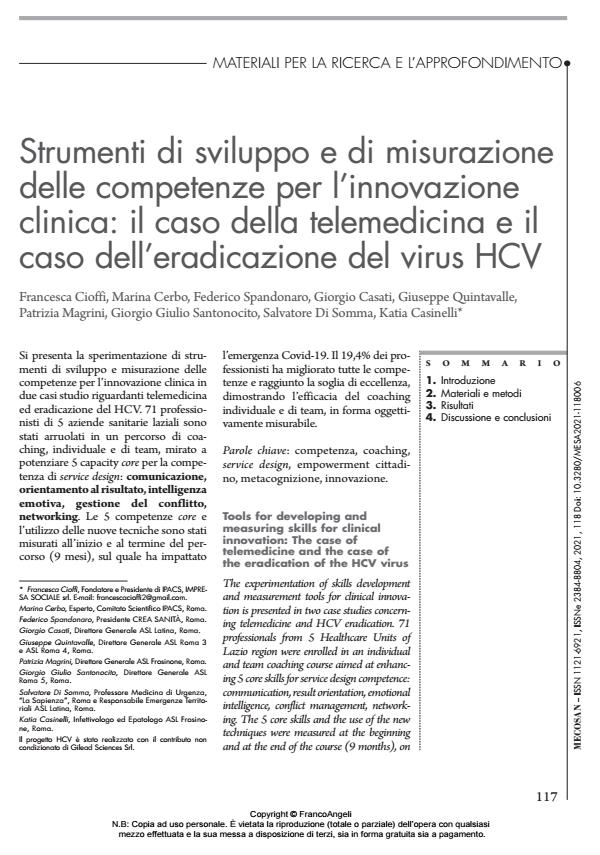Tools for developing and measuring skills for clinical innovation: The case of telemedicine and the case of the eradication of the HCV virus
Journal title MECOSAN
Author/s Francesca Cioffi, Marina Cerbo, Federico Spandonaro, Giorgio Casati, Giuseppe Quintavalle, Patrizia Magrini, Giorgio Giulio Santonocito, Salvatore Di Somma, Katia Casinelli
Publishing Year 2021 Issue 2021/118
Language Italian Pages 20 P. 117-136 File size 278 KB
DOI 10.3280/MESA2021-118006
DOI is like a bar code for intellectual property: to have more infomation
click here
Below, you can see the article first page
If you want to buy this article in PDF format, you can do it, following the instructions to buy download credits

FrancoAngeli is member of Publishers International Linking Association, Inc (PILA), a not-for-profit association which run the CrossRef service enabling links to and from online scholarly content.
The experimentation of skills development and measurement tools for clinical innovation is presented in two case studies concerning telemedicine and HCV eradication. 71 professionals from 5 Healthcare Units of Lazio region were enrolled in an individual and team coaching course aimed at enhancing 5 core skills for service design competence: communication, result orientation, emotional intelligence, conflict management, networking. The 5 core skills and the use of the new techniques were measured at the beginning and at the end of the course (9 months), on which the Covid-19 emergency had an impact. 19.4% of professionals improved all the skills and reached the threshold of excellence, demonstrating the effectiveness of individual and team coaching, according to an objectively measurable structure.
Keywords: competence, coaching, service design, citizen-empowerment, metacognition, innovation.
- How does emotional intelligence act on institutional policies? A new set of behaviors
to facilitate implementation of the Recovery and Resilience Plan (RRP) in local health units in Italy Francesca Cioffi, Marina Cerbo, Federico Spandonaro, Giorgio Casati, Daniela Sgroi, Gerardo Corea, Rossella Moscogiuri, Lina Delle Monache, in Health Psychology Report /2023
DOI: 10.5114/hpr/166564
Francesca Cioffi, Marina Cerbo, Federico Spandonaro, Giorgio Casati, Giuseppe Quintavalle, Patrizia Magrini, Giorgio Giulio Santonocito, Salvatore Di Somma, Katia Casinelli, Strumenti di sviluppo e di misurazione delle competenze per l’innovazione clinica: il caso della telemedicina e il caso dell’eradicazione del virus HCV in "MECOSAN" 118/2021, pp 117-136, DOI: 10.3280/MESA2021-118006